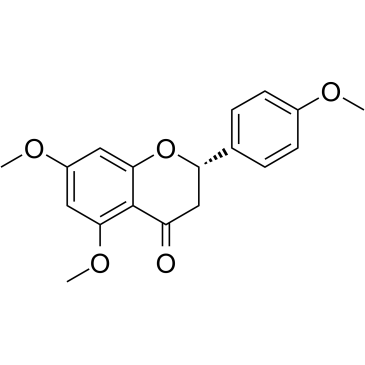
Naringenin trimethyl ether
CAS No. 38302-15-7
Naringenin trimethyl ether( —— )
Catalog No. M18499 CAS No. 38302-15-7
Naringenin trimethyl ether shows significant molluscicidal activity with a median lethal concentration (LC(5)) of 3.9 μg/mL.
Purity : >98% (HPLC)
 COA
COA
 Datasheet
Datasheet
 HNMR
HNMR
 HPLC
HPLC
 MSDS
MSDS
 Handing Instructions
Handing Instructions
| Size | Price / USD | Stock | Quantity |
| 5MG | 252 | In Stock |


|
| 10MG | 374 | In Stock |


|
| 25MG | 620 | In Stock |


|
| 50MG | 885 | In Stock |


|
| 100MG | 1197 | In Stock |


|
| 200MG | Get Quote | In Stock |


|
| 500MG | Get Quote | In Stock |


|
| 1G | Get Quote | In Stock |


|
Biological Information
-
Product NameNaringenin trimethyl ether
-
NoteResearch use only, not for human use.
-
Brief DescriptionNaringenin trimethyl ether shows significant molluscicidal activity with a median lethal concentration (LC(5)) of 3.9 μg/mL.
-
DescriptionNaringenin trimethyl ether shows significant molluscicidal activity with a median lethal concentration (LC(5)) of 3.9 μg/mL.
-
In Vitro——
-
In Vivo——
-
Synonyms——
-
PathwayOthers
-
TargetOther Targets
-
RecptorOthers
-
Research AreaOthers-Field
-
Indication——
Chemical Information
-
CAS Number38302-15-7
-
Formula Weight314.33
-
Molecular FormulaC18H18O5
-
Purity>98% (HPLC)
-
Solubility——
-
SMILESCOC1=CC=C(C=C1)C2CC(=O)C3=C(C=C(C=C3O2)OC)OC
-
Chemical Name——
Shipping & Storage Information
-
Storage(-20℃)
-
ShippingWith Ice Pack
-
Stability≥ 2 years
Reference
molnova catalog



related products
-
3beta-Hydroxylanosta...
3beta-Hydroxylanosta-8,24-diene-21-al may have cancer cell growth inhibitory activity against P388, HL-60, L1210 and KB cell lines.
-
Adipic acid
From an industrial perspective, it is the most important dicarboxylic acid, mainly as a precursor for the production of nylon.
-
13-Diaminopropane
13-Diaminopropane is a common synthesis reagent used in the synthesis of cholinesterase inhibitors and thrombosis inhibitors.



 Cart
Cart
 sales@molnova.com
sales@molnova.com


